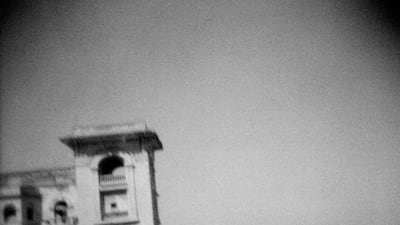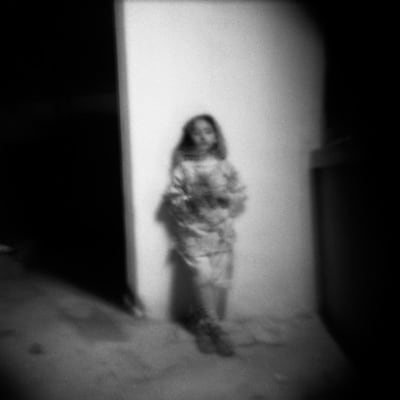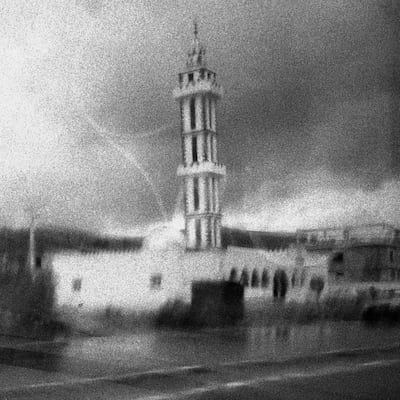A photography exhibition about the life of the Martinique-born philosopher and psychiatrist Frantz Fanon opens at The Project Space at New York University Abu Dhabi (NYUAD) this Thursday.
Fanon fought in the Free French Army during the Second World War and studied psychiatry in Lyon. A radical thinker, he was one of the first people in Europe to write about the psychological impact of racism on an individual. His 1952 and 1956 books on racism, colonialism and psychiatry influenced post-colonialism theory and pan-Africanism.
At Project Space, the philosopher's story is told through the lens of French photographer Bruno Boudjelal, who travelled to Fanon's birthplace on the Caribbean island, the psychiatric hospital where he worked in Algeria, his home in Ghana and his grave on the Algerian-Tunisian border. The resulting 23 black-and-white photographs reflect Boudjelal's search for physical traces of Fanon's memory.
The philosopher spent most of his life in Algeria after the publication of his 1953 book, Black Skin, White Masks, which consolidated his thesis on the psychological effects of colonial subjugation. There, says Boudjelal, he is nearly forgotten and blurred photos – white feet on a dark stairwell, fish in a pond – capture the periphery of where Fanon lived and wrote, rather than the concrete.
"For me, this series has a strong meaning of how can you look at traces of history in the country now," says the photographer. "It's total amnesia of what they have, not only for Frantz Fanon, but the process of independence."
It is a process that Boudjelal knows only too well. He began his work in Algeria in 1993 when, at age 22, he decided to search for his father's family, of whom he knew nothing. The civil war had started. His father was against the idea.
"He said: 'Bruno that's not your story, you don't have to go there. I don't want you to go there'. We had a big quarrel and I said, 'I told you that Algerie is my story and I will go there'."
His father travelled with him to Algeria in 1997, his first trip back in 40 years. An earlier series by Boudjelal, Disquiet Days, explores his relationship with his father and his family history, but also tells the story of daily life in the civil war and Algeria's troubled relationship with its own past. Ironically, the photographer's introduction to Fanon came on the other side of the Atlantic, when he was on a holiday with his wife visiting her relatives in Martinique. On a visit to a family cemetery in Fort-de-France, she mentioned that Fanon was from the area, and teased her husband for his unfamiliarity with the philosopher's work. Years later, he chanced upon the writer's home in Ghana on a road trip. Only then did he decide to pursue the series in Algeria.
Boudjelal travelled to the psychiatric hospital in Blida, where Fanon worked many times between 2009 and 2013. After being turned away at the gate on four occasions, he gave up. While trying to see Fanon's grave in the eastern Algerian village of Aïn Kerm, the Frenchman was turned back at a checkpoint.
It is fitting for the disconnect between Algeria and its history, says Boudjelal. "All the series, all my quest about Fanon in Algerie, it's about failure, because nowhere did I get to go where I wanted to go."
His black-and-white photos show subjects out of focus and in the shadows. In one, the edge of a three-storey colonial building beside the sea that Fanon wrote about, is just visible. Once a French casino, it was used as a teaching centre during the Algerian War of Independence and was later abandoned.
The images are evocative of Fanon's isolation, says Robert Young, the dean of arts and humanities at NYUAD.
"When he moved to France, he felt alienated from society because he wasn't made to feel welcome, he was made to feel different," says Young, a scholar of postcolonial literatures and editor of Fanon's uncollected writings. "One of the things he said was, 'I just want to be treated like a man like any other, I don't want to be pointed at or marked out because I'm black or foreign'."
Last year, Young published two plays by Fanon that he discovered in French archives.
"Some people in France are very critical of him, but for a younger generation, his work in relation to racism and injustice is striking quite a chord with people. It's unfortunate that it's still relevant today."
Young and Boudjelal will be speaking at the exhibition's opening at The Project Space on Thursday at 6pm. On Monday, September 18, NYUAD Theatre Programme will present a reading of Fanon's play, The Drowning Eye.
The exhibition runs until October 27, from 3pm until 10pm, Saturdays through Thursdays.
Presented in collaboration with the NYUAD Arts and Humanities department, the works are on loan from Autograph ABP, a London-based charity that works in photography and film, cultural identity, race and human rights.
www.nyuad-artgallery.org/en_US/project-space/
_________________________
Read more:
Why I will always remember the Louvre Abu Dhabi I saw first
Campus Art Dubai: the art of conversation
NYUAD announces its September events
_________________________



